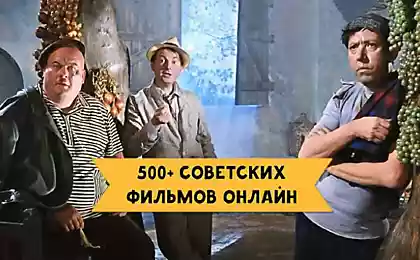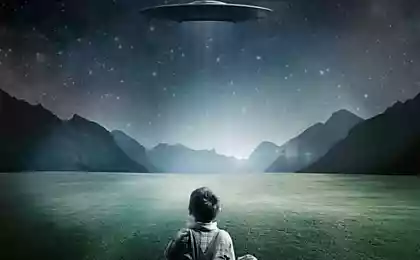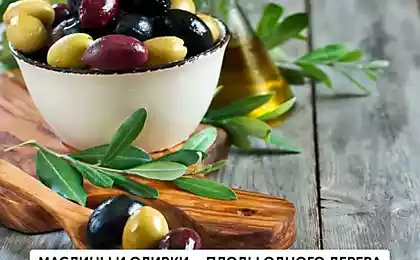1175
Alien Fiction
In the movies and on TV, we often show strange alien worlds, planets, and these often present some "theme". One Planet - it's just a huge solid wood, the other - a vast snowy wilderness, on the third full Nazis. But it is obvious that the world is not so arranged. Everyone knows that the only "theme" of any real world - it is the indomitable and terrible horror. That's about it, then I'll ...
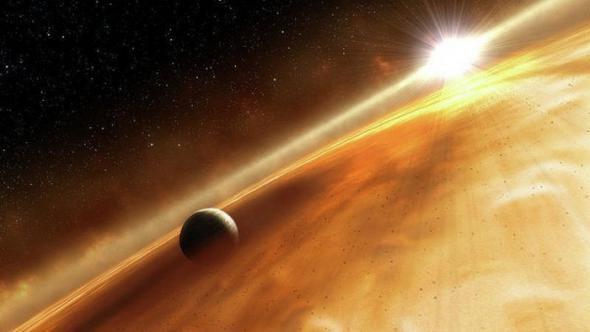
The planet, devouring light
Try to imagine hell as a planet. Some of you probably think of the sinister and the red rocks from the heat, hot enough to melt that easily Terminator. And someone in the imagination will picture a giant black ball of death, where the light is literally dying. Congratulations. Together, you have just imagined the distant giant known as TrES-2b.
Orbits a star in the constellation Draco (a little known fact: most of the titles in space gave the film director John Carpenter) TrES-2b is the darkest of all the planet discovered by man. How black? It absorbs (or devours, if you please) 99 percent of the incident sunlight from outside. Thus, it is blacker than coal, blacker than black acrylic paint, ink cold and unforgiving heart of your ex. And this planet is unlikely to ever be hungry, since it is only 4, 8 million kilometers from its star. In astronomical terms it's like you're standing next to another man, leaning into each other's noses.
But it also means that you never have landed on this planet of darkness like Robinson, and you do not get off her mad with loneliness ... because you just kill temperature TrES-2b, which is only five times less than the Sun's surface. This heat is dotted with the black surface of the planet infernal lakes of magma.
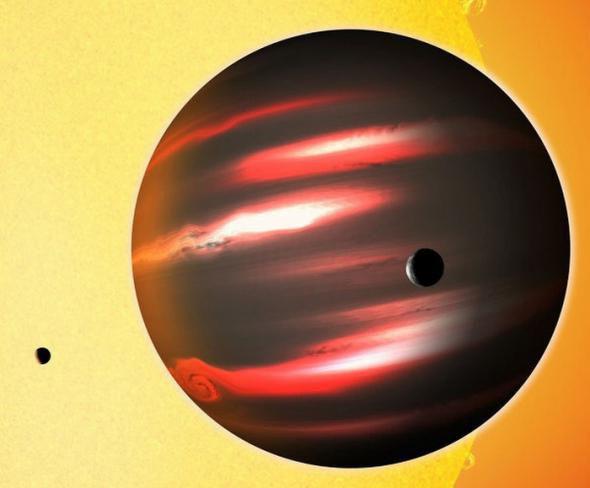
So, TrES-2b absorbs almost all fall on her way light and impenetrable blackness broken only by the planet sea of molten death of the size of Earth. Due to the heat of the devil TrES-2b is not formed clouds, and, according to some scientists, this partly explains why it is so blackest black. But this does not explain the voracious appetite with which she devours sunlight. Theories on this subject a lot. Perhaps this is due to the lack of any kind was the atmosphere. Perhaps the blame light-absorbing particles such as vaporized sodium or gaseous titanium oxide, which swim around the planet. Personally, I think this is due to the fact that a free contiguous tectonic plates TrES-2b is literally blackened by hatred after the millennial fidgeting on the hard nucleus of the planet.
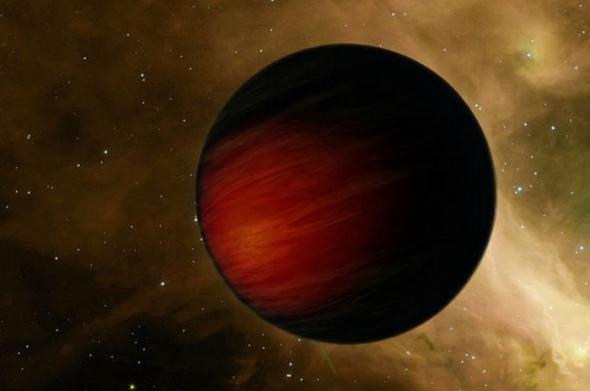
A planet passing through the Eye of Sauron
Eye of Sauron - a wonderful name given to the young star Fomalhaut, together with the surrounding debris. Together, they are very similar to a giant eye in outer space ...
That does not blink ...
Which is eternal ...
Who looks over your shoulder from the depths of infinity ...
Oh, how stupid - to endow a star human qualities. What it is, if the true picture is far worse? Here's an example. Space debris, stones, ice and dust create a giant disc of an eye, which is about twice as much of our entire solar system. That is the scale with which we are dealing - and it seems that the whole day is lost if the girl from the wrong Starbucks made you cappuccino. Finely swim, gentlemen.
At a distance of 25 light years from Earth, the celestial body the size of Jupiter, called Fomalhaut b orbits the star at the center of an eye. Since this is only a small gull on a vast junkyard of space debris, it is likely that this planet is constantly crashes into the garbage, creating a planetary scale fireworks from burning rocks and exploding ice.
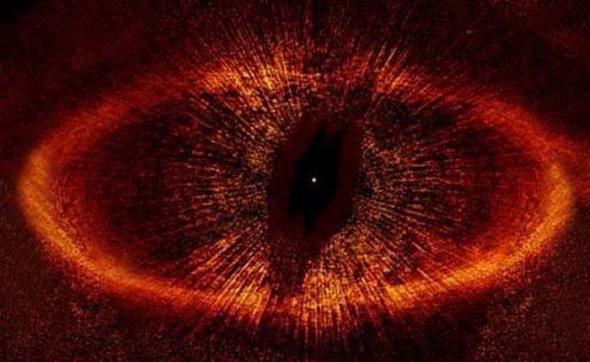
But things get much worse if you think that Fomalhaut b passes this cruel and merciless cycle only because of the fact that another planet pushes it to the near circumstellar orbit, dooming to eternal destruction. It is a real curse of space, and from it is quite possible to make a very decent film in the genre of space thriller (with planets instead of people).
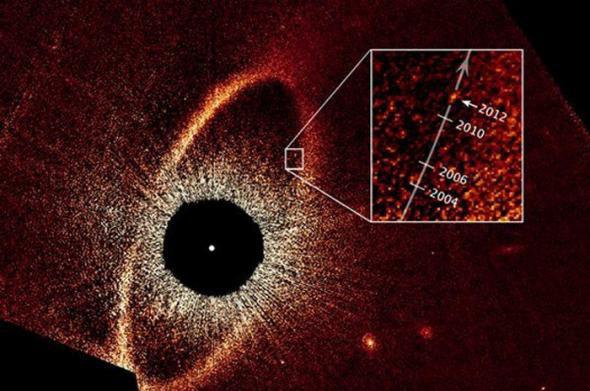
Evaporating planet
KIC 12557548 b - a planet that is slowly trying to torture death of her own star. Well, a little bit exaggerated. Let's say, less dramatic. Astronomers have discovered an exoplanet, which literally evaporate before our eyes, dragging the dusty cometary tail. The tail of this similar to the trail of blood left by desperate calls upon the aid of the victim, which drags along the ground the killer. But aid still does not come ...
For more scientific accuracy. Planet KIC 12557548 b orbits its star in just 16 hours. This means that the temperature on its surface is too high for the existence of rocks, minerals, and even walking the guy who wears the pants in the winter cold. But that's not all. Apparently, the universe looked at the dying KIC 12557548 b, its melting mountain rivers of magma and decided that it is not enough. On KIC 12557548 b seen colossal volcanic eruptions literally planetary scale. They are so powerful that the ash flies into space. Actually, no, ash evaporates due to cosmic radiation, because the fly with KIC 12557548 b is not nothing can.
But enough about KIC 12557548 b. Let's talk about you, special and beautiful you ...
... And all the horrors that priklyuchatsya with you if you stepped onto the KIC 12557548 b.
Firstly, on top you will look awesome bright star, which occupies half the sky. But the time to marvel at the sky on fire you will not because you'll be breathing in the atmosphere, 90% of which is powdered rock? Then, if you do not finish off instantly numerous earthquakes and volcanic eruptions (and they finish off, and for a couple of nanoseconds, but in the interests of our narrative, I'll let you live a few more terrible and painful minutes), you carry away into space and turned to dust with the rest 100,000 tonnes of pulp, which disappear from the planet every second.
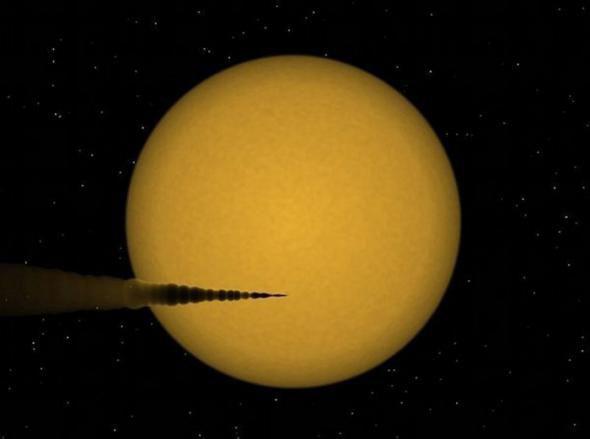
The planet, which is constantly executed
It would look like "Sunrise" hot Neptune Kepler-36c when viewed from the surface of super-Earths Kepler-36b
Kepler-36b - is the smallest planet and a half times the size of Earth. And it forever and ever offend older sister, Kepler-36c, which is similar to Neptune, being a gas giant. Two planets orbiting the stars in the constellation Cygnus, while the orbits of the planets are very close to each other. Unfortunately, this leads to the fact that they meet periodically so close that the elder planet causing serious damage to the youngest. At the time of convergence of Kepler-36c is literally satisfied with the execution of Kepler-36b, but instead of bullets it has enormous power of attraction that turns small relative to one big mess of earthquakes and volcanic eruptions, battering its surface.
But even worse is that the younger sister no second out to recover after another thrashing. When volcanoes erupt on it longer, 36c appears again, stinking fumes, and again begins his bullying. And this happens every 97 days as scheduled. Every three months, Kepler-36b is undergoing an almost complete devastation and no time to recover in between. Nonetheless holding youngest and certainly every time getting angrier. We know how it would end. Showboat small can only be for the time being, because suddenly they can bellow, grab a knife in his hands - and go destroy everything around. We give Kepler-36c several millennia, and I promise you - the younger sister finally could not bear going to kick ass and older, or what there still are planets authorities whipping.

The planet, which is a horizontal rain of glass at about 6500 kilometers per hour
Appearance HD 189733b is deceptive. At first glance, it seems suitable to stay and is very similar to Earth: a blue ball, no rings, flames and impenetrable darkness. You can imagine that there are clouds and some form of intelligent life that has not yet found out what Earthlings incorrigible ass. What we do not fly back at full speed?
The fact is that in reality HD 189733b - is just torture for interplanetary space travel. It is absolutely not suitable for life. This is the planet on which literally go showers of glass fragments.
Its atmosphere contains a large number of silicon particles that scatter blue light. Goluba30679.jpg & quot; data-social = «vk: 1241630» class = «window_open» & gt; Vkontakte Share Share with friends Create demotivator Add inscription on the photo
--img8--
Source:

The planet, devouring light
Try to imagine hell as a planet. Some of you probably think of the sinister and the red rocks from the heat, hot enough to melt that easily Terminator. And someone in the imagination will picture a giant black ball of death, where the light is literally dying. Congratulations. Together, you have just imagined the distant giant known as TrES-2b.
Orbits a star in the constellation Draco (a little known fact: most of the titles in space gave the film director John Carpenter) TrES-2b is the darkest of all the planet discovered by man. How black? It absorbs (or devours, if you please) 99 percent of the incident sunlight from outside. Thus, it is blacker than coal, blacker than black acrylic paint, ink cold and unforgiving heart of your ex. And this planet is unlikely to ever be hungry, since it is only 4, 8 million kilometers from its star. In astronomical terms it's like you're standing next to another man, leaning into each other's noses.
But it also means that you never have landed on this planet of darkness like Robinson, and you do not get off her mad with loneliness ... because you just kill temperature TrES-2b, which is only five times less than the Sun's surface. This heat is dotted with the black surface of the planet infernal lakes of magma.

So, TrES-2b absorbs almost all fall on her way light and impenetrable blackness broken only by the planet sea of molten death of the size of Earth. Due to the heat of the devil TrES-2b is not formed clouds, and, according to some scientists, this partly explains why it is so blackest black. But this does not explain the voracious appetite with which she devours sunlight. Theories on this subject a lot. Perhaps this is due to the lack of any kind was the atmosphere. Perhaps the blame light-absorbing particles such as vaporized sodium or gaseous titanium oxide, which swim around the planet. Personally, I think this is due to the fact that a free contiguous tectonic plates TrES-2b is literally blackened by hatred after the millennial fidgeting on the hard nucleus of the planet.

A planet passing through the Eye of Sauron
Eye of Sauron - a wonderful name given to the young star Fomalhaut, together with the surrounding debris. Together, they are very similar to a giant eye in outer space ...
That does not blink ...
Which is eternal ...
Who looks over your shoulder from the depths of infinity ...
Oh, how stupid - to endow a star human qualities. What it is, if the true picture is far worse? Here's an example. Space debris, stones, ice and dust create a giant disc of an eye, which is about twice as much of our entire solar system. That is the scale with which we are dealing - and it seems that the whole day is lost if the girl from the wrong Starbucks made you cappuccino. Finely swim, gentlemen.
At a distance of 25 light years from Earth, the celestial body the size of Jupiter, called Fomalhaut b orbits the star at the center of an eye. Since this is only a small gull on a vast junkyard of space debris, it is likely that this planet is constantly crashes into the garbage, creating a planetary scale fireworks from burning rocks and exploding ice.

But things get much worse if you think that Fomalhaut b passes this cruel and merciless cycle only because of the fact that another planet pushes it to the near circumstellar orbit, dooming to eternal destruction. It is a real curse of space, and from it is quite possible to make a very decent film in the genre of space thriller (with planets instead of people).

Evaporating planet
KIC 12557548 b - a planet that is slowly trying to torture death of her own star. Well, a little bit exaggerated. Let's say, less dramatic. Astronomers have discovered an exoplanet, which literally evaporate before our eyes, dragging the dusty cometary tail. The tail of this similar to the trail of blood left by desperate calls upon the aid of the victim, which drags along the ground the killer. But aid still does not come ...
For more scientific accuracy. Planet KIC 12557548 b orbits its star in just 16 hours. This means that the temperature on its surface is too high for the existence of rocks, minerals, and even walking the guy who wears the pants in the winter cold. But that's not all. Apparently, the universe looked at the dying KIC 12557548 b, its melting mountain rivers of magma and decided that it is not enough. On KIC 12557548 b seen colossal volcanic eruptions literally planetary scale. They are so powerful that the ash flies into space. Actually, no, ash evaporates due to cosmic radiation, because the fly with KIC 12557548 b is not nothing can.
But enough about KIC 12557548 b. Let's talk about you, special and beautiful you ...
... And all the horrors that priklyuchatsya with you if you stepped onto the KIC 12557548 b.
Firstly, on top you will look awesome bright star, which occupies half the sky. But the time to marvel at the sky on fire you will not because you'll be breathing in the atmosphere, 90% of which is powdered rock? Then, if you do not finish off instantly numerous earthquakes and volcanic eruptions (and they finish off, and for a couple of nanoseconds, but in the interests of our narrative, I'll let you live a few more terrible and painful minutes), you carry away into space and turned to dust with the rest 100,000 tonnes of pulp, which disappear from the planet every second.

The planet, which is constantly executed
It would look like "Sunrise" hot Neptune Kepler-36c when viewed from the surface of super-Earths Kepler-36b
Kepler-36b - is the smallest planet and a half times the size of Earth. And it forever and ever offend older sister, Kepler-36c, which is similar to Neptune, being a gas giant. Two planets orbiting the stars in the constellation Cygnus, while the orbits of the planets are very close to each other. Unfortunately, this leads to the fact that they meet periodically so close that the elder planet causing serious damage to the youngest. At the time of convergence of Kepler-36c is literally satisfied with the execution of Kepler-36b, but instead of bullets it has enormous power of attraction that turns small relative to one big mess of earthquakes and volcanic eruptions, battering its surface.
But even worse is that the younger sister no second out to recover after another thrashing. When volcanoes erupt on it longer, 36c appears again, stinking fumes, and again begins his bullying. And this happens every 97 days as scheduled. Every three months, Kepler-36b is undergoing an almost complete devastation and no time to recover in between. Nonetheless holding youngest and certainly every time getting angrier. We know how it would end. Showboat small can only be for the time being, because suddenly they can bellow, grab a knife in his hands - and go destroy everything around. We give Kepler-36c several millennia, and I promise you - the younger sister finally could not bear going to kick ass and older, or what there still are planets authorities whipping.

The planet, which is a horizontal rain of glass at about 6500 kilometers per hour
Appearance HD 189733b is deceptive. At first glance, it seems suitable to stay and is very similar to Earth: a blue ball, no rings, flames and impenetrable darkness. You can imagine that there are clouds and some form of intelligent life that has not yet found out what Earthlings incorrigible ass. What we do not fly back at full speed?
The fact is that in reality HD 189733b - is just torture for interplanetary space travel. It is absolutely not suitable for life. This is the planet on which literally go showers of glass fragments.
Its atmosphere contains a large number of silicon particles that scatter blue light. Goluba30679.jpg & quot; data-social = «vk: 1241630» class = «window_open» & gt; Vkontakte Share Share with friends Create demotivator Add inscription on the photo
--img8--
Source:
